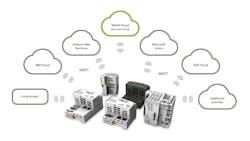Bridging the Gap from IIoT Promise to IIoT Reality
What you’ll learn:
- How to manage the expectations concerning ease of implementation of IIoT tools.
- The challenges associated with implementation.
- Strategies to bridge the gap between expectations and reality.
Having access to large amounts of data from every corner of operations and every machine detail can be very enticing. In fact, it’s so attractive that the industry can’t help but market intriguing terms like industrial IoT (IIoT) with great promises of ease and cost-effectiveness. Such promises ring true for those who know how to do it or get it done (Fig. 1).
IIoT has been around for many years. It entails collecting data points from sensors and controllers and bringing visibility to that data for better decision-making. Thus, IIoT is truly a thousand points of light shining on the processes with just as many connections between them. However, those connections must be created and managed.
Fortunately, newer tools and technologies are available to make this all easier, faster, and more manageable. They also allow for an architecture that resembles more of a spider web than a pyramid. This differentiates today’s IIoT from yesterday’s traditional controls hierarchy.
As with any technological advance, though, the journey from expectations to reality presents a significant challenge. The need to bridge the gap between the promises the products hold (or the ones that product manufacturers make) and the actual outcomes they deliver has become paramount. The benefit of these new technologies is great. One must just ensure the expectation of what it takes to reap the reward is accurate.
Promises: Managing IIoT Expectations
Although the products promise ease of implementation, it’s not always quite so simple. Certain features of products need to be highlighted. The manufacturers’ literature does a great job of showcasing these features. However, they’re also positioned as a perfect fit for your process because of their ability to work in any application.
The responsibility for ensuring a compatible product, though, lies with the consumer. It’s always important to look deeper than the brochure or other marketing material. We’ve seen polished animated videos showing the concept of getting data or changing automation controllers or servo drives basically with the click of a button (or mouse). But the reality of actual implementation usually turns out to be vastly different. As the popular saying goes, “You don’t know what you don’t know.”
If you don’t know what goes into the details, it seems easy. The classic “hand wave” beckons of the days sitting in a math class when the teacher says, “and you go through a bunch of steps” and you get the answer! But then you get back home only to find out you have no idea what those steps are. Once you learn those steps, yes, they’re easy...however, when you don’t know them, figuring out what to do next can seem so daunting.
A response we often give to the question “Is it easy?” is that it’s a lot like downhill skiing: It’s easy once you know how to do it, but are we talking about a Beginner, Intermediate, or Expert ski run?
Integrating new technologies to bring data from the devices on the end of the communication line on machines—devices like sensors, relays, and signal lights, etc.—is much more complicated than using those devices the way they are currently being used. New configuration tools, programming methods, and software all need to be learned. Protocols must be selected for homogeny.
“It shouldn’t be this hard.” Have you ever heard that? It’s typically the frustrated response of somebody who bought the expectation that they didn’t need to learn much, and that everything would magically just start working.
Reality: The Challenges of Implementing IIoT
When I see the word “easy” on a spec sheet or marketing literature, my brain involuntarily makes a scowl and says “yeah, sure.” Let’s refer to the polished videos mentioned earlier. In some cases, because technologies are advancing so rapidly, nobody really knows how to do what the video shows. The only way to manage your expectations is by digging deeper.
Has anyone actually implemented the tool/software/feature you’re being asked to buy? Can you call an expert and get help on short notice? Does. It. Really. Exist? (Fig. 2)
Employees at a company may not embrace change because it almost always comes with struggle. Learning and applying new products or technologies takes time and effort. Operating in a familiar way comes with less anxiety. It’s important not to underestimate the hurdle of an experienced person learning new technologies.
When technology evolves, it requires a new thought process. I remember buying a tablet computer, rather than a traditional laptop, just so I could figure out why anybody would want one. For years I didn’t understand why people were texting when they already had email on their phones, which made texting seem redundant to me.
With true customization comes inevitable complexity. Every machine is unique. Even machines that accomplish the same task, like labelers from two different companies, have subtle differences in the way they do their job. So, a solution presented as “one size fits all” will often not fit without some tailoring.
Keep in mind the law of unintended consequences. Often in machine modification, every action has some reaction. Not always equal and opposite, but a reaction, nonetheless. Do you know what that’s going to be?
It’s important to be a student and ask questions—many questions. Put your mindset in the role of a child who is willing to listen to his or her parents. You only have “today” in mind, but those you’re trying to learn from have history, experience, and a longer view of the scenario than you do.
There’s so much to learn as you apply new technology. Processes, products, companies, people, and experience are infinitely variable. There’s just no substitute for experience, and you get experience by not getting what you want. Once again, dig deep and make sure that you or your company has the knowledge to take on the implementation or integration of a device or technology you’ve never used before.
We’ve spent hours working with documented information and manufacturer-supplied configuration files for EtherNet/IP, DeviceNet, and EtherCAT networking projects, only to find out that we were given the wrong files.
Strategies to Bridge the IIoT Gap
Bridging the gap is seldom a simple task. However, some strategies should help ease the process. First and foremost, take the time to evaluate. Engage the right people in your company who are eager to learn about the new technology. This eagerness should translate to finding out how to make new technology or products fit your systems and work on your machines rather than finding reasons “it’ll never work.”
Next, it will often benefit to set up a kind of “Pilot” program. When possible, take small bites to prove the concept and then build on small victories.
Always keep in mind that it’s about the journey and not a destination. This concept keeps those engaged in the process motivated to continue to learn and internalize the approach.
Finally, explore the possibility of forming a strategic partnership. This could be the most important part of the process. Partner with manufacturers, distributors and integrators who can help you along the journey. Find out if they’ve actually used the technology or product before. Use the partners who have come through in the past and avoid the ones that just want to sell products to you.
About the Author
Corey Foster
Director of Automation Sales & Application Engineering, Valin Corp.
Corey Foster, MID, is the Director of Automation Sales & Application Engineering at Valin Corporation, a leading technical solutions provider for the technology, energy, life sciences, natural resources and transportation industries.
Ray Marquiss
Sr. Application Engineer, Valin Corp.
Ray Marquiss is a Sr. Application Engineer at Valin Corporation, a leading technical solutions provider for the technology, energy, life sciences, natural resources, and transportation industries.


